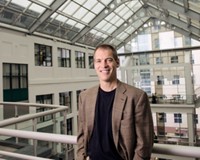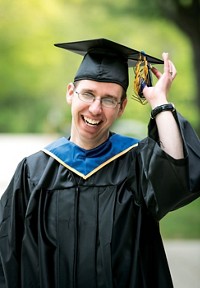Advertisement
Grab your lab coat. Let's get started
Welcome!
Welcome!
Create an account below to get 6 C&EN articles per month, receive newsletters and more - all free.
It seems this is your first time logging in online. Please enter the following information to continue.
As an ACS member you automatically get access to this site. All we need is few more details to create your reading experience.
Not you? Sign in with a different account.
Not you? Sign in with a different account.
ERROR 1
ERROR 1
ERROR 2
ERROR 2
ERROR 2
ERROR 2
ERROR 2
Password and Confirm password must match.
If you have an ACS member number, please enter it here so we can link this account to your membership. (optional)
ERROR 2
ACS values your privacy. By submitting your information, you are gaining access to C&EN and subscribing to our weekly newsletter. We use the information you provide to make your reading experience better, and we will never sell your data to third party members.
Careers
Two-Body Solution
How dual-chemist couples found happiness, job satisfaction, and work/life balance
by Sophie L. Rovner
May 8, 2006
| A version of this story appeared in
Volume 84, Issue 19

There are many ways to achieve fulfillment as a chemist. It's just a little more challenging when there are two in the family.
That was the take-home message of a discussion of "The Two-Body Problem" that took place in March at the American Chemical Society national meeting in Atlanta. The session was part of a Division of Chemical Education symposium on balancing one's personal and professional lives.
Achieving that balance was a key objective for Karen J. C. and Mark A. Muyskens. When they met as graduate students at the University of Wisconsin, Madison, they discovered they shared a number of values. "We each felt very strongly that we valued time with family and wanted to be able to spend time with our children at home, especially when they were young," Karen said.
Equally important, "we each wanted to teach at an undergraduate liberal arts college," she said. But "we realized that the probability of finding two tenure-track positions in physical chemistry at undergraduate colleges would be very unlikely, especially close geographically to each other."
So Karen and Mark set out to find a college that would hire them as a team. As it turned out, "many colleges were really flexible and were willing to look at alternate arrangements for hiring," Karen said.
In fact, the arrangement has worked out well for the Muyskens and their chosen institution: Karen and Mark have been sharing a full-time faculty position in the chemistry department at Calvin College in Grand Rapids, Mich., for the past 17 years.
The couple now has three children, who range in age from a kindergartener to an eighth-grader. Typically, one spouse spends part of each day on the Calvin campus while the other spouse stays at home with the kids, and then they flip roles.
Karen and Mark split their teaching responsibilities 50-50, each usually teaching one course with a lab per term. They also keep service duties, including committee work and student advising, fairly equal. "We get asked to do different things," Karen said. "The college is pretty good-and we remind them when we need to that we're the equivalent of one full-time faculty member." They are assigned their own advisees and belong to different committees.
The Muyskens' main research effort, on the other hand, is a joint endeavor. They apply for grants as coprincipal investigators and take sabbaticals together.
For their summer research projects, the Muyskens plan each week in advance, scheduling particular experiments, data analysis, and instrument maintenance and repair. Keeping each other abreast of the latest developments takes a lot of communicating. There are some inefficiencies, Karen conceded. She and Mark also each have independent "side projects" so they can pursue individual research interests.
On the whole, sharing a job has paid off for the Muyskens. "At a small college like Calvin, normally there would be just one person in physical chemistry, and now we have two," Karen explained. "We have a built-in collaboration." In their joint research, "we benefit from complementary strengths and personalities. Mark is especially good at computer programming and fixing instruments and big-picture thinking, and I'm better at more detailed thinking."
Likewise, each can incorporate the other's ideas in their courses. "I really see the benefit of having another person to bounce ideas off of who has similar training and interests," Karen said. "That's also been a big benefit in terms of grant proposals."
The downside is that "we're each on campus less than we would be if we were full-time," Karen said. "There are some costs in terms of collegiality-there's less time to see and meet with our colleagues. Our student access is less, so we have to be very specific about when we're on campus so students know when to find us."
Another frustration for Karen is the sense that there's more she would like to accomplish both at work and at home. "I have had to realize that on both ends there are things I just can't do," she said. On the other hand, "I have to realize that I do get to teach and do research, both things which I just love, and I do get to be home with my kids, and I love that, too."
The Muyskens aren't yet sure whether they'll change their lifestyle once their kids have grown up. "We may be very happy with this arrangement for our whole career," Karen said.
Their combined wages equal those of a single full-time professor. They share some benefits, such as life insurance, but each receives the full allotment of some other benefits, including health insurance.
From a financial standpoint, "we don't feel like it's been a huge sacrifice," Karen said. "The house that we've chosen to live in and the vacations we choose are consistent with one salary. We don't expect to go to Europe. We're happy to go camping."
Like the Muyskens, Craig M. and Mary Anne A. Teague got an early start on their planning, jointly plotting out their future career paths while they were still in grad school at the University of Illinois. The couple, who met at the school, married in 2001.

Mary Anne originally planned to get a doctorate. But she switched to a master's degree after realizing in grad school that she loved teaching "and would be perfectly happy never to do lab research," according to Craig. "Plus, we were already thinking about our future and the fact that we didn't both necessarily want tenure-track jobs." The Teagues want to start a family, and "we didn't necessarily want to wait until tenure to start having children," Craig said.
After earning her master's degree in 2001, Mary Anne had no trouble finding teaching work. Knowing that positions would be readily available for Mary Anne freed the couple to concentrate on Craig's job prospects when he received his Ph.D. in 2003.
Craig, a physical chemist, selected Cornell College in Mount Vernon, Iowa, for the launch of his academic career. He teaches six courses per year. The college operates on a block plan, in which students take one course at a time. A course lasts for 18 days and then the students switch to another course.
The pace is hectic. When Craig is teaching a course he puts in a workweek of at least 60 hours. "When I'm not teaching, it's much more flexible, so I can tailor my schedule to exactly what I need to do," he said. "It's less than 60 hours, but probably still 40." Part of his time is spent on research, which he conducts primarily in the summer.
Mary Anne also puts in long hours. She is currently teaching at a small liberal arts college and two large community colleges. She also sometimes teaches at Cornell College, "although she taught at Cornell for only one block this spring to preserve her sanity," as Craig put it. Mary Anne plans to cut back on her hours this coming year. "The beauty of Mary Anne's situation is this flexibility-to work a lot when she wants to, and less when she doesn't," Craig said.
There's another benefit to the adjunct lifestyle, Craig said. "In some ways, it's the best part of teaching-interacting with the students but not having to deal with faculty committees or some of the other headaches that tenure-track faculty" face.
Mary Anne sometimes ponders whether to go back and get a doctorate in chemistry or education. The extra degree would get her a raise at the places she currently teaches. And in the future, it would open more doors for full-time jobs "so she wouldn't have to work at four schools at the same time," Craig said.

High school sweethearts Stacey Lowery Bretz and Richard L. Bretz married in 1991 while in grad school at Cornell University. After earning their Ph.D.s, the couple moved to Berkeley for Stacey's postdoc at the University of California. Shortly after arriving in Berkeley, Stacey became pregnant with their first child.
Although the couple had been told there would be plenty of industry jobs for Richard in the area, it took a while for him to find one. As an interim measure, he filled in at Evergreen Oil for a chemist on maternity leave. Afterward, he worked as an industrial research chemist at ChemTrace and taught as an adjunct professor at San Francisco State University.
In 1995, Stacey and Richard moved to Michigan. Stacey was an assistant professor in chemical education at the University of Michigan, Dearborn, and Richard became an adjunct professor. In some ways, the couple would have preferred a full-time position for Richard, but Stacey had recently given birth, "so adjunct was just fine with us." The department chair eased the child care situation by making sure Stacey and Richard weren't teaching at the same time.
After the birth of their second child, Richard took a full-time job as a visiting professor at the University of Toledo, in Ohio, for a year. Then he switched to Ford Motor as a senior research chemist.
Then Youngstown State University, in Ohio, recruited Stacey-who interviewed 10 days before giving birth to the couple's third child-to develop a graduate program for high school chemistry teachers. The university promised to help Richard find a job with local industry, but when nothing came through, Richard became an adjunct professor in the chemistry department. Stacey began looking for another job so she could tell the provost, "I'm leaving and taking my grants with me unless somebody gets serious about these promises."
The university responded by creating an appealing position for Richard as an assistant provost on university/high school partnerships. He developed a program that brings students at risk of dropping out to the Youngstown campus to complete their high school education.
Last fall, Miami University in Oxford, Ohio, recruited Stacey to expand its Ph.D. program in chemistry education. Richard is a temporary visiting assistant professor and is pursuing a permanent position.
When the couple first set out on their respective careers, they didn't actively plan for Richard to be the "trailing spouse." But the academic career opportunities in Stacey's field of chemistry education were limited by the small size of her specialty, particularly at the start of her career. On the other hand, Richard's training as an analytical chemist was much more broadly applicable, Stacey noted.
Richard told C&EN that his career path might not suit everyone, particularly given the number of employer and project changes. "But I've been able to work on a number of exciting and unrelated projects," he said. At the same time, he added, it's a challenge to convince potential employers that they can benefit from his wide array of skills.
Richard had intended to join Stacey in describing their experiences at the ACS national meeting. But their child care arrangements fell through, so Richard stayed home with the kids, who are now in kindergarten, third grade, and fifth grade. That kind of tradeoff comes with the territory when juggling a marriage, two chemists, and three children.
It's a "myth that you can have it all, that you don't have to choose work or family," Stacey said. And the myth is damaging "because every time you take stock of your life, you feel like you're failing against that metric," she said. "I prefer to say that you can have both a family and professional success, but you will make choices, and you will make sacrifices for both."
Another myth that mentors dispelled for Stacey and Richard concerned finding a good time to start a family. "If you wait for a good time, you won't be having children," Stacey remarked. She is always upfront with potential employers about her family. "If I have to hide the fact that my family is important to me during an interview, then that's probably not a place I want to be."

Melissa D. Hellman and Casey C. Raymond met while they were in grad school at Colorado State University, in Fort Collins. "We started our two-body problem when Casey left for his postdoc" at Northwestern University in Evanston, Ill., Melissa said. They were engaged for 18 months while Melissa finished up at Colorado State.
Advertisement
After marrying in 1998, the couple moved to northeastern Ohio, where Casey had accepted a position at Kent State University. "At this point, he knew he'd be teaching, but I didn't have a clue what I was going to do," Melissa said. She did some research on campus but soon realized that she didn't enjoy working in a lab.
As an alternative, she began teaching a summer course at a satellite campus of Kent State in North Canton. Later, she took a job doing writing, editing, and design work in Battelle Memorial Institute's Cleveland office. After 18 months of the 100-mile-a-day commute, she quit and started her own company doing similar work. The flexibility of Melissa's schedule allowed the couple to spend time together when Casey had a free moment. But those moments were few and far between.
Eventually, Melissa said, "we realized that Casey's work at Kent State was devouring him." He loved teaching, but "good teaching is not as recognized as it probably should be" at many Ph.D.-granting institutions, she said. "And most of his time was taken up with research."
The couple spent a year looking for another institution where Casey could concentrate on teaching. They found the State University of New York, Oswego, where Casey joined the chemistry department in 2003.
After moving to New York, Melissa began applying for locally advertised positions, but because she was overqualified, she "got turned down for every single job, which was really depressing." Meantime, the couple was juggling two mortgages on a single paycheck because they'd been unable to sell their Ohio home.
In 2005, things began looking up. Melissa found a part-time position teaching introductory chemistry at SUNY Oswego in the spring term. She also taught a physics lab at the campus. That summer, the Ohio house finally sold, and Melissa found out that SUNY Oswego would need her to teach chemistry full-time for the entire 2005-06 school year. This semester she's teaching two lecture classes and three lab sections for nonscience majors.
She's also participating in a new class designed and taught by her husband and a colleague. The team is teaching students about the science of fermentation, including the chemistry involved in beer and bread production. The students and instructors will head to Belgium later this semester for further study.
Now, said Melissa, "we both enjoy our work. And since we're teaching some of the same classes, we talk about work together more than ever."
Even so, the couple is careful to maintain a degree of separateness on campus. "While it's nice to be able to drop down the hall" to confer with each other, "we need our own space," Melissa said. "If I need to get something done and I don't want anybody bugging me, I close my office door, or I leave my office and go somewhere else."
Having traveled a long and twisting route to arrive at their current position in life, "we're both very happy," Melissa said. No doubt she spoke for many two-chemist couples when she said, "It has not been easy, but it's been worth it."





Join the conversation
Contact the reporter
Submit a Letter to the Editor for publication
Engage with us on Twitter